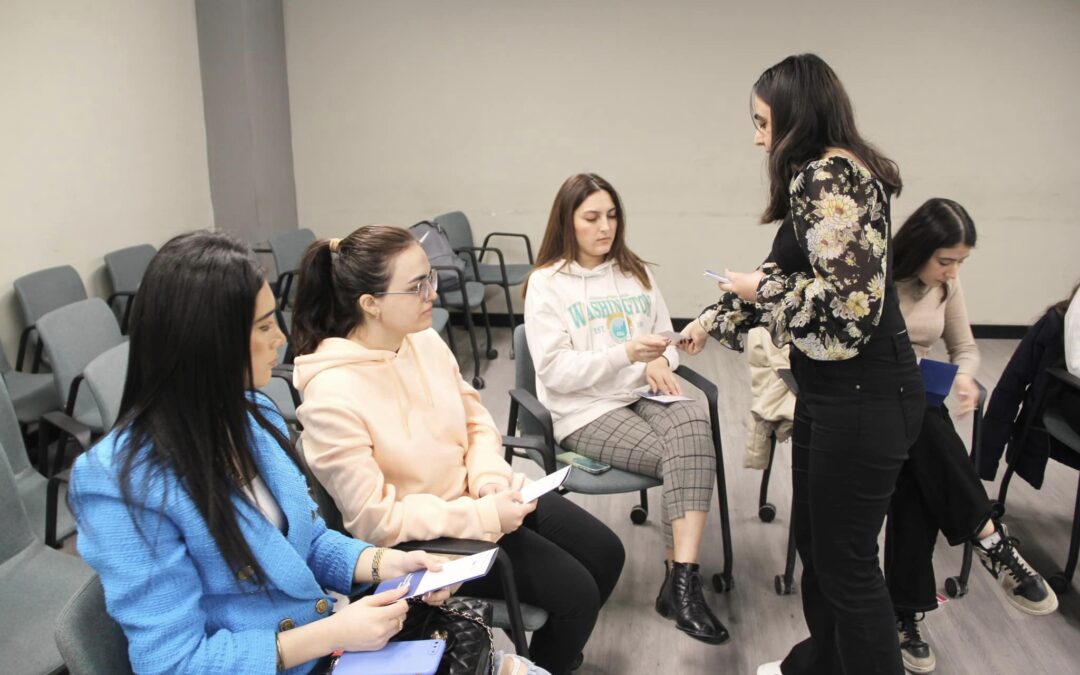By Fatima Asadova, a youth worker, Secretary of International Relations and Programme at the National Youth Council of Azerbaijan (NAYORA)
After the interactive training sessions in Passau, Germany, my colleague and I had the opportunity to organize and implement several methods taught during the sessions at the local level. The main objective of these activities was to build mutual understanding and support the peace movement among young and old people by using innovative methods such as “Oral History”, “Living Library”, and “Suitcase of My Life”.
The “Oral History” activity was designed to provide participants with an opportunity to hear directly from people affected by the conflict. Before the training session, we had the testimonies of the conflict-affected people in a video format, which included details about how the conflict shaped their lives and their families, personal experiences, and their hopes and messages for peace. During the training session, the trainer explained what the project aimed to achieve, the culture of remembrance, the oral history method, and how to prepare interview questions, deal with conflict-affected people, and storytelling. After watching the videos, the trainer led discussions based on guiding questions to build up to the conclusion on how to support the peace movement and build mutual understanding through young people. A total of 18 participants took part in this activity, and they expressed their positive impressions, stating that they learned about the personal experiences of people and their lives before the conflict, as well as the culture of remembrance, and how it can be effective in the peace movement.
The “Living Library” activity was designed to provide participants with an opportunity to ask questions and engage with people who lived in the Karabakh region of Azerbaijan before the war started in 1992. I started by explaining the project’s objectives, the culture of remembrance, and the oral history method. The two living books shared their memories, and participants asked them questions about their personal experiences and their thoughts on the future of the issue. Then me and my colleague Ramin led discussions on what the students learned about the living books, the most interesting part, what was new for them, and whether they would participate in the living library activity again. 11 young people participated in this activity, and they expressed their desire to participate in such events more frequently.
The “Suitcase of My Life” life activity was the most challenging and required more preparation. We worked with a local youth NGO called “Great Return”, which works largely with conflict-affected people. With their support, we were able to engage participants from an older generation, which is difficult due to their lack of interest and awareness of intergenerational activities. We announced an open call for young people interested in participating in such initiatives. The activity was divided into three main parts: an introductory workshop, a preparatory meeting, and a final meeting. In the introductory workshop, participants learned about the suitcase of my life method, its importance, and the steps required to implement such an activity, as well as information about donors, partners, project activities, and objectives. In the preparatory meeting, participants got familiar with the idea of tandem creation, working in pairs, and creativity workshops. In the final meeting, with the involvement of young and old people, tandems were completed and ready for display. A total of 30 participants took part in this activity, and 21 of them were young people who expressed their appreciation for the activity’s unique combination of art, creativity, and real-life experiences.
Overall, my experience with the local activities was insightful and challenging. Working with the conflict-affected people and engaging young and old individuals in innovative activities required patience, creativity, and a deep understanding of the local context. However, the positive feedback and interest from the participants and the local community showed that these activities were successful in building mutual understanding and supporting the peace movement. My message to others is to continue organizing such activities, build partnerships with local NGOs, and engage young and old people in meaningful and creative ways.

